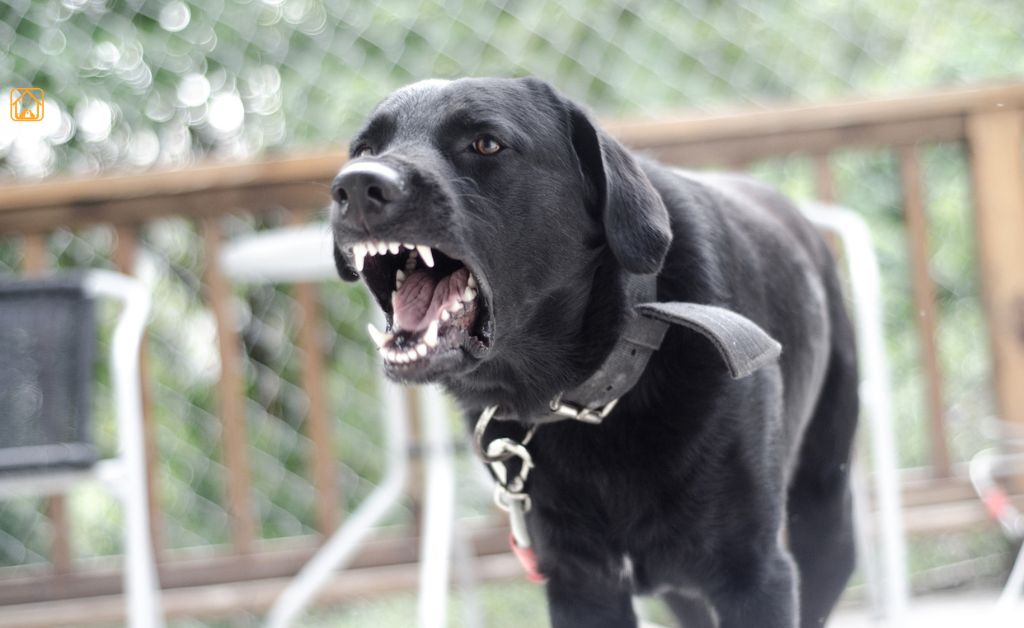Why Do Dogs Bark? Understanding Barking Types
Barking is your dog’s way of talking. But sometimes, it seems like they have a lot to say! Dogs bark for many reasons, and understanding these triggers is the first step in how to stop dog barking. Here are some of the most common causes:
Types of Dog Barking
- Alarm Barking: Dogs are natural watchdogs. They might bark at the mail carrier, a squirrel, or anyone passing by your window. If you’ve ever thought, “My dog barks at everything that passes by,” you’re seeing this instinct in action.
- Territorial or Protective: Territorial or protective barking is a natural instinct in dogs. They bark to alert you or to guard their space from strangers, sounds, or other animals.
- Attention-Seeking: Some dogs quickly realize barking gets a reaction. Maybe they want to play, go outside, or just have your attention. A bored dog is a noisy dog. Without enough mental or physical stimulation, barking fills the void.
- Anxious Barking: Dogs left alone, startled by noises, or feeling insecure may bark excessively. Separation anxiety is a huge culprit here, especially in puppies or rescues.
- Excitement or Playful Barking: Some dogs bark from pure happiness during playtime or when greeting family and friends.
- Medical Issues: Sometimes, pain, hearing loss, or neurological problems cause increased barking. If the behavior is sudden or seems out of character, always check with your vet first.
- Compulsive Barking: This is rare, but some dogs develop a habit of barking just to bark. You might see repetitive movements or circling at the same time.
Ever noticed how your dog barks at the window every time someone walks by? That’s classic alert barking, one of the trickiest habits to break, but not impossible! Dogs aren’t trying to annoy you. They’re communicating the only way they know how.
You know what’s funny? I once met a Golden Retriever who barked, without fail, every time the kitchen timer dinged. Turns out, the timer meant “food’s ready,” and he didn’t want anyone to forget! Dogs connect sounds and routine in ways that would surprise you.
How to Identify the Barking Reason?
Ever thought of how to stop dog barking in the house? Don’t worry, even I went through it. It all starts with understanding what sets them off. Identifying triggers is a detective job, but it’s key for successful Excessive Barking training in dogs.
- Keep a Barking Log: For a week, jot down when and where your dog barks. What’s happening right before the barking? Who’s nearby? Are there certain sounds, times of day, or visitors?
- Watch Body Language: Sometimes, your dog’s posture gives you the answer. Are they tense, wagging their tail, or pacing? A relaxed dog barking at play is different from a dog barking out of fear.
- Look for Patterns: Do they bark only when alone? Only at the window? Maybe it’s always at dinner time. Patterns point to the root cause.
- Consider the Environment: New house? More foot traffic? Construction noises? Changes can trigger barking in even the calmest pups.
- Rule Out Health Issues: If barking is sudden, out of character, or paired with other changes like pacing, soiling indoors, or loss of appetite, talk to your veterinarian.
Here’s the weird part, some dogs will bark for reasons we never expect. I once had a neighbor whose beagle only barked when she wore her red coat. No other color.
Once you spot the triggers, you can move on to targeted training. This is where excessive barking training tips become truly effective, and you’ll see real change both in your dog’s behavior and your own stress levels.
Step-by-Step Training Methods to Stop Excessive Barking
1. Identify Triggers & Remove Temptation
- As mentioned above, observe your dog to learn when and why they bark.
- Common triggers include the doorbell, people passing by, or boredom.
- Block their view if they bark at windows, or provide more playtime if it’s due to boredom.
2. Teach the Quiet Command
- Wait for your dog to bark. Calmly say “quiet.”
- When they stop, even for a second, praise and give a treat.
- Repeat regularly and slowly increase the quiet time before giving a reward.
3. Positive Reinforcement for Barking
- Dogs often bark to get your attention. Instead of scolding, try the opposite.
- Praise and treat your dog when they are calm and quiet.
- If they bark to get your attention, ignore them completely.
- This helps them learn that being quiet gets rewarded, not barking.
4. Desensitization to Triggers
- Expose your dog to the trigger like a doorbell at a distance where they stay calm.
- Play the trigger sound at low volume and reward calm behavior.
- Gradually increase intensity over time, keeping sessions short and positive.
5. Provide More Exercise & Mental Stimulation
- Make sure your dog is getting enough daily exercise.
- Add mental stimulation with puzzle toys, training games, or scent walks.
- A tired and mentally engaged dog barks less out of boredom or frustration.
6. Stay Consistent
- Make sure everyone in the home follows the same training approach.
- Avoid mixed signals, consistency helps dogs learn faster.
- Celebrate small progress, and remember even slow improvement is success.
Don’t stress if progress is slow. I remember when my Bunny took weeks to learn “quiet”, but one day, it clicked. Patience pays off.
How to Stop Dog Barking at Night and When Alone
Nighttime barking and separation barking are tough for everyone. Here’s what helps:
- Calm Bedtime Routine: Evening walks and a cozy bed can settle nerves.
- White Noise or Music: Blocks out startling sounds that trigger barking.
- Comfort Items: A worn shirt or favorite toy can soothe anxious dogs.
- Gradual Alone Training: Practice leaving for short periods, slowly increasing time away.
- Check for Needs: Make sure your dog isn’t barking for water, bathroom, or pain.
Tip: I started leaving a stuffed toy with my dog at night. It gave him something to focus on and kept him calm until he quietly drifted off to sleep.
Special Cases: Puppy Barking & Barking at Noises
Puppies and barking go hand in hand, sometimes it feels like your new little buddy has only two settings: asleep or making noise! That’s totally normal, but it’s never too early to start Excessive Barking training for puppies.
Puppies often bark because they want attention, are excited, or simply don’t know what else to do. I remember when my own pup, Shiro, would bark at her own reflection in the mirror. It was adorable, but also a sign she needed some guidance.
- Keep training sessions short and fun. Puppies have brief attention spans, so five-minute sessions work best. Use treats, gentle praise, and toys to keep things positive.
- Teach the “quiet” cue early. When your puppy barks, wait for a pause, then say “quiet” in a calm voice and immediately reward the silence. Repeat, and celebrate every little win.
- Redirect unwanted barking. If your puppy barks at noises or people passing by, distract them with a favorite toy or start a quick game. This helps teach them that calm behavior gets your attention, not barking.
- Socialize, socialize, socialize! Expose your puppy to different people, pets, and environments. Confidence-building makes them less likely to bark at every new thing.
- Ignore attention-seeking barks. If your puppy barks to demand cuddles or food, wait for quiet before responding. It feels hard, but it works wonders.
- Reward calmness. Catch your puppy being quiet and relaxed, and reward them, even if it’s just a gentle pat. Puppies learn quickly what earns praise.
Every puppy is different. Some pick up quiet cues in a week, while others need more time. Stay patient, stay consistent, and remember, puppyhood is a whirlwind, but you’re shaping a lifetime of good habits. If you need more ideas, check out our puppy training basics guide.
What NOT to Do: Common Mistakes and Ineffective Methods
Let’s clear the air, there are plenty of products and quick-fix methods out there that promise to stop barking in seconds. But some of these approaches can do more harm than good, making barking problems worse or even hurting your dog’s trust in you.
- Avoid punishment-based tools. Shock collars, citronella collars, and ultrasonic devices might seem like an easy fix, but they often cause fear, anxiety, or aggression. They don’t teach your dog what to do instead and can damage your bond. You can refer to our guide on tools to find the right ones that make training easier and more effective.
- Don’t yell back. Yelling at a barking dog usually sounds like you’re joining in! Dogs don’t understand the words, they just hear more noise and excitement.
- Never use physical corrections. Throwing objects, spraying water, or physically scaring your dog is not only unkind, it can make barking (and other behavior issues) much worse.
- Avoid anti-bark collars. These can punish the wrong dog or cause confusion and stress among all your pets.
- Don’t reward barking, even by accident. If you give attention, treats, or let your dog outside right after barking, you might reinforce the behavior without realizing it. Wait for quiet before rewarding your dog.
- Surgery is not a solution. Procedures like debarking are considered inhumane by most experts and don’t address the underlying cause, they only muffle the noise, not your dog’s distress.
When to Seek Professional Help or Vet Advice
If you’ve tried excessive barking dog training steps and nothing works, or if barking is paired with aggression, destructive behavior, or sudden changes, it’s time to get help.
- Consult your vet to rule out medical issues.
- Contact a certified dog trainer or veterinary behaviorist for personalized advice.
Sometimes, a fresh perspective makes all the difference, and saves your sanity.
FAQs About How to Stop Dog Barking
1. What is the most effective way to stop dog barking?
Teaching the “quiet” command with positive reinforcement is consistently effective. Identify why your dog barks and use treats, praise, and redirection to reward silence. Consistency and patience are key!
2. How do I stop my dog barking in seconds?
Interrupt with a calm cue like “quiet,” redirect their focus with a treat or toy, and reward the pause. For instant results, practice this technique daily so your dog learns what’s expected.
3. Why does my dog bark at everything that passes by?
This is often alert or territorial barking. Block their view, use white noise, and reward quiet moments. Over time, your dog will learn that silence, not noise, brings good things.
4. Can I train my puppy to stop excessive barking?
Absolutely! Start early with gentle redirection, lots of positive reinforcement, and desensitization to triggers. Ignore barking for attention, and always reward calm, quiet behavior.
5. How do I stop dog barking at night?
Establish a bedtime routine, provide comfort items, and use white noise to block out noises. Rule out medical issues and make sure your dog’s needs are met before bedtime.
6. What if my dog barks when left alone?
This could be separation anxiety. Gradually build up alone time, leave toys for distraction, and consider consulting a professional for tailored advice.
7. Should I use anti-barking collars or devices?
These are not recommended as a first option. They can cause fear or aggression and don’t address why your dog barks. Instead, focus on training and positive reinforcement, or seek professional help.
8. When should I see a vet about barking?
If barking starts suddenly, is paired with changes in behavior, or you suspect pain or illness, check with your vet. Medical issues, hearing loss, or cognitive decline can all increase barking.
9. Can professional trainers help with excessive barking?
Yes, certified trainers and behaviorists offer personalized plans and support for even the toughest cases of excessive barking. Don’t hesitate to ask for help, it’s what they’re there for!
10. Are there special tips for barking in multi-dog households?
Train each dog individually first, then work on group calm. Avoid punishment. Use plenty of rewards for quiet group behavior, and manage triggers as much as possible.
Conclusion
Remember, every dog is different, but with time, love, and a little know-how, you’ll both find your quiet place.



